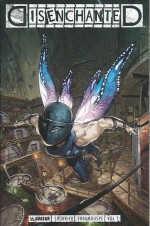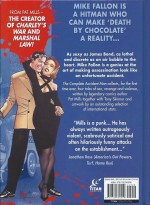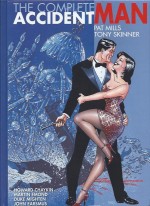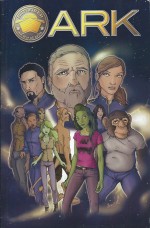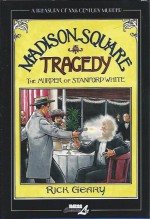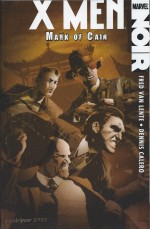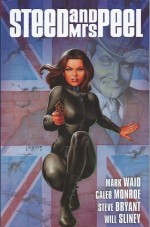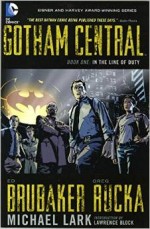
By Ed Brubaker, Greg Rucka & Michael Lark & Stephen Gaudiano (DC Comics)
ISBN: 978-1-4012-1923-9 (HC)Â Â Â Â Â Â Â : 978-1-4012-2037-2 (SC)
One of the great joys of long-lasting, legendary comics characters is their potential for innovation and reinterpretation. There always seems to be another facet or corner to develop. Such a case was Gotham Central, wherein modern television sensibilities cannily combined with the deadly drudgery of the long-suffering boys in blue of the world’s most famous four-colour city.
Owing as much to shows such as Hill Street Blues, Homicide: Life on the Streets and Law & Order as it did to the baroque continuity of Batman, the series mixed gritty, authentic police action with a soft-underbelly peek at what the merely mortal guardians and peacekeepers had to put up with in a world of psychotic clowns, flying aliens and scumbag hairballs who just won’t stay dead.
This compilation – collecting Gotham Central #1-10 (February – October 2003, by writers Ed Brubaker and Greg Rucka and sublimely illustrated by Michael Lark) – revisits those much-missed stories in either standard paperback or lavish hardcover format and starts off with an erudite and informative Introduction on ‘The Mean Streets of Gotham’ by celebrated crime author Lawrence Block.
Brubaker and Rucka co-wrote the eponymous two-part premier tale ‘In the Line of Duty’ wherein a desperate child-kidnap investigation by detectives Marcus Driver and Charlie Fields of ex-Commissioner Gordon‘s hand-picked Major Crimes Unit leads them all unawares to the temporary hideout of murderous superfreak Mr Freeze.
The cold killer horrifically destroys Charlie and sadistically leaves Driver injured but alive as an object lesson.
The GCPD have a strange relationship with the Dark Knight. They all know he’s out there, but the official line is that he’s an urban myth and the Administration refuses to acknowledge his existence. Thus a civilian is employed to turn on the bat-signal on the roof when crises occur and the public are told the eerie light is simply used to keep the cowardly, superstitious underworld cowed…
In such circumstances all real cops are loath to ask for The Bat’s help so Driver and his grieving, angry colleagues pull out all the stops to find and capture Freeze before the masked vigilante insultingly finishes their job for them.
However, as night falls and the frozen bodycount rises, Marcus deduces what Freeze is planning and has no choice but to ask new Police Commissioner Akins to suspend his embargo and call in the whacko expert before hundreds more die…
From an era when comicbook noir was enjoying a superb renaissance, this classic take on the theme of the hunt for a cop-killer is a masterpiece of edgy and fast-paced tension whilst simultaneously perfectly introducing a large cast of splendidly realised new and very individual players…
Brubaker scripts the second story solo as ‘Motive’ finds the again fit-for-duty Driver and his temporary partner Romy Chandler using solid police work to solve the outstanding kidnap case, all the while under the gun as arson villain The Firebug dances on the horizon burning down the city one building at a time.
Fourteen year old babysitter Bonnie Lewis vanished while walking home from her yuppie client’s house and a subsequent ransom demand later proved to be a fake. Now, after her body is found, Driver and Chandler carefully re-examine the facts and discover that almost everybody involved has been lying…
As they methodically sift evidence, alibis and possible motives, they begin to realise that even this tragically normal crime has its roots in both common greed and the gaudy madness of Gotham’s metahuman menaces…
The gripping procedural drama then segues back to the city’s aristocracy of maniacs as Greg Rucka scripts ‘Half a Life’ with focus switching to Renee Montoya: a solid cop with too many secrets.
After her former partner Harvey Bullock was fired with extreme prejudice, tongues started wagging, but now an old case threatens to destroy her career and end her life…
When arresting rapist Marty Lipari, he tried to stab her, and she subdued him. Now her morning is ruined when the skel sues her for ten million dollars in damages.
It only gets worse when she and partner Crispus Allen get a bogus case dumped on them by the corrupt, lazy meatheads in Robbery Division, but the capper is dinner with her traditional, devout Catholic parents who still want her to settle down and have kids…
Her life begins to truly unravel when a photo of her kissing another woman does the round of colleagues, friends and family. Not all her fellow cops are homophobic bigots: but just enough that’s she kept her life private for years. Now, apparently outed by Lipari’s hired gumshoe Brian Selker, she is targeted by Internal Affairs when first the PI and then Lipari himself are shot to death.
With her lover Darla threatened, her gun identified as the murder weapon and a huge amount of illicit drugs found in her apartment, Renee is soon on her way to jail – another bad egg just like Bullock.
Nobody in MCU thinks she’s guilty but the evidence is overwhelming, and the crisis comes when en route she’s busted out by masked men and taken to the hidden citadel of one of Batman’s most nightmarish nemeses…
Utterly alone, in the unfriendliest job in the world, in the nastiest town on Earth, Montoya has to deal alone with a crazed maniac who’s destroyed her life just so he can be with her forever.
As a Major Crimes Detective she’s seen how bad The Bat’s enemies can get, but this time she’s the target, not the hunter or witness, and it’s not just her life at stake…
This engrossing drama never steps outside of human bounds irrespective of the nature of evil in Gotham, and the original comic presentation (from issues #6-10) won Eisner, Harvey, Eagle and Prism awards for Best Story in 2003.
Sadly not included in this volume are the two earlier tales from Renee’s past (Batman Chronicles #16 – Two Down, by Rucka & Jason Pearson & Cam Smith, and Detective Comics #747 – Happy Birthday Two You, by Rucka, William Rosado & Steve Mitchell) which explained that oblique connection to her obsessive suitor – although you can find then in the original 2005 trade paperback Gotham Central: Half a Life.
The appropriate quota of human drama, tension, stress and machismo all play well under Michael Lark’s deftly understated illustrations, adding a grimy patina of pseudo-reality to good old fashioned cops ‘n’ robbers stories, played out in what can only be described as the urban city of the damned.
The procedural cop thriller on the edge of hell is a stunning study in genre-crossing storytelling, and this edition includes a full cover gallery by Lark as well as a fulsome section of designs and character sketches in ‘Staffing the GCPD’.
Dark, suspenseful and so very addictive, this is a book no batfreak or crime buff can afford to miss.
© 2004, 2005, 2008 DC Comics. All Rights Reserved.


